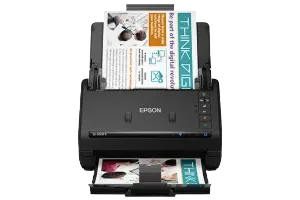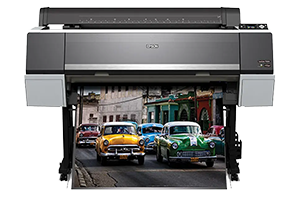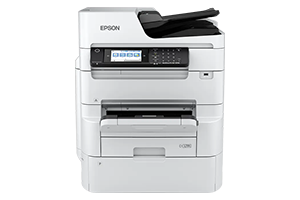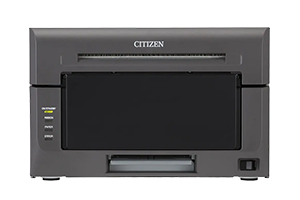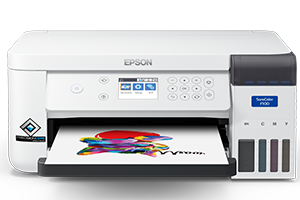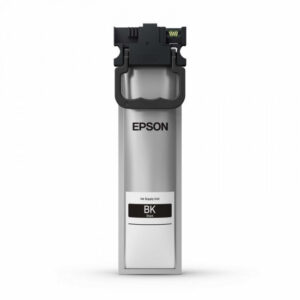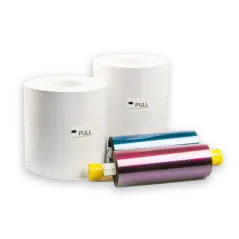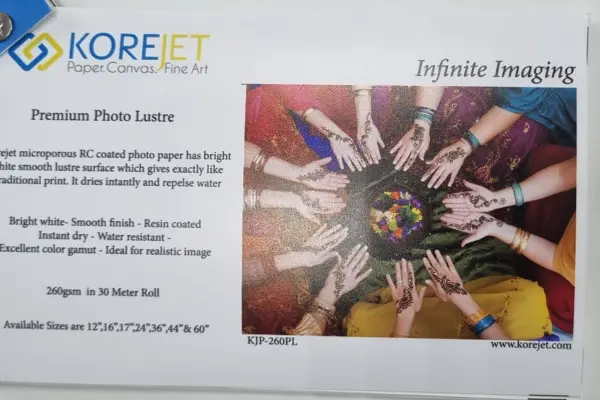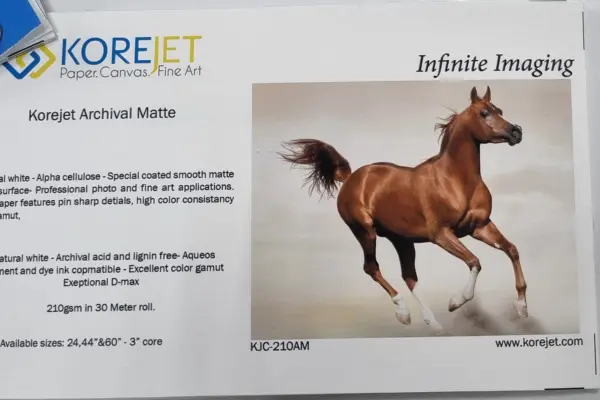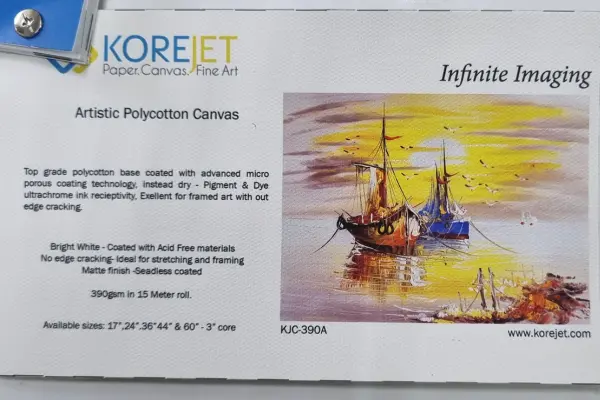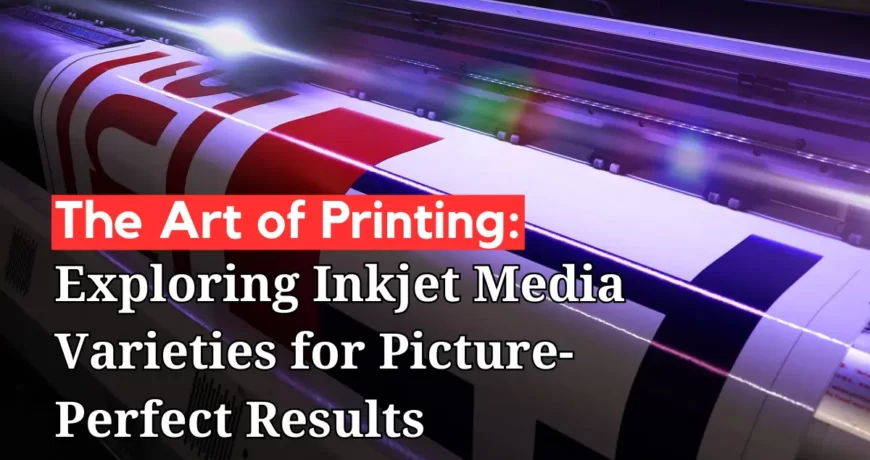
The Art of Printing: Exploring Inkjet Media Varieties for Picture-Perfect Results Leave a comment
Introduction
In the realm of inkjet printing, inkjet printers aren’t just about the machine; the type of paper or media you use plays a crucial role in how your prints turn out. From glossy photo paper to textured specialty sheets, the diversity of inkjet printer media options is both vast and intriguing. Each type of media possesses its unique characteristics, influencing the quality, texture, and finish of the printed material. Understanding these distinctions empowers creators to choose the perfect canvas for their artistic endeavors or professional documents. In this comprehensive exploration, we embark on a journey through the world of inkjet printer media. We uncover the nuances between various types of commonly used printing paper.
Whether you are a seasoned printing enthusiast or a curious newcomer, join us as we delve into the myriad options available. Together, we will unlock the secrets behind selecting the ideal media to bring your visions to life.
What is meant by Inkjet Media?
Inkjet media encompasses a wide array of specialized materials tailored for compatibility and optimal performance with inkjet printers. These materials are designed to cater to diverse printing needs across various industries and personal applications. Inkjet media primarily encompasses various types of paper. These range from standard multipurpose paper to specialized photo paper with different finishes, such as glossy, matte, or satin. These variations cater to specific requirements, ensuring that the printed output achieves the desired quality, sharpness, and vibrancy.
These materials undergo precise formulation and treatment to absorb ink effectively while maintaining sharpness, color vibrancy, and durability. Inkjet papers, for instance, vary in weight, finish, and texture, catering to diverse printing preferences, from matte surfaces ideal for text-based documents to glossy finishes that accentuate vibrant images. Photo papers within this category offer a spectrum of options, from lustrous sheens to pearlized textures, enhancing the visual appeal of printed photographs. Canvas and fabric inkjet media are designed to replicate artistic textures. This allows digital art or photographic images to be printed and displayed with an authentic, tactile feel. Transparencies, on the other hand, cater to presentations and overlays, offering a clear and crisp medium for projecting images or text onto surfaces.
In essence, inkjet media constitutes a versatile range of substrates tailored to exploit the capabilities of inkjet printers. The diversity of options ensures that users can attain superior print quality across a spectrum of applications. This includes everything from everyday documents to high-resolution photographs and artistic creations.
Exploring Inkjet Media Types: Understanding Printing Surfaces
Embarking on a visual journey through the realm of inkjet printing surfaces unveils a world rich in diversity and nuance. From the pristine finishes of photo papers to the textured depths of fine art papers and the versatile canvas of inkjet media, each substrate tells a unique story, enhancing the artistry and impact of printed images. Delving into this array of surfaces promises a deeper understanding of how they influence colors, textures, and the overall aesthetic appeal of printed works.
Photo Papers
Photo papers constitute a diverse category in the spectrum of printing surfaces, meticulously crafted to enhance the visual allure of printed photographs. Engineered with varying finishes, weights, and textures, these papers cater to a broad array of printing needs, offering options such as glossy, matte, satin, and metallic finishes. Glossy photo papers, with their reflective surfaces, give images a vibrant, sharp, and high-contrast appearance. This makes them ideal for showcasing vivid colors and deep blacks. Conversely, matte photo papers present a non-reflective, textured surface that reduces glare and provides a more subdued, artistic look. This quality is often favored for black-and-white photographs or images requiring a softer touch.
Inkjet Media for Professional Photographers
Photo papers find extensive applications in diverse settings. From professional photographers seeking to exhibit their work in galleries to amateur enthusiasts printing personal memories, photo papers offer an avenue to immortalize moments with exceptional clarity and detail. These types of printer inkjet media are also a staple in commercial printing for marketing materials, brochures, and high-quality promotional prints. This is particularly crucial in scenarios where capturing attention with striking visuals is paramount.
Understanding the nuances of photo papers involves considering factors such as paper weight, coating, and compatibility with specific ink types. Lighter weights might be suitable for everyday printing needs, while heavier weights ensure durability and a more luxurious feel. Additionally, the coatings on these papers, whether resin-coated (RC) or porous, influence their ability to absorb ink, impacting the final print’s sharpness and color vibrancy. It’s crucial to match the paper type with the printer and ink technology for optimal results.
Ultimately, photo papers stand as a versatile canvas, elevating the impact and longevity of printed images across artistic, personal, and professional landscapes.
Fine art Inkjet Media
Fine art inkjet papers represent a pinnacle of sophistication in the realm of printing surfaces. They are designed to meet the discerning needs of artists, photographers, graphic designers, and fine art printers seeking archival-grade prints. Crafted from premium materials like cotton rag or alpha-cellulose, these papers boast a diverse array of textures, including smooth, textured, and even watercolor-like surfaces. Consequently, this contributes to the uniqueness of each print.
Best Inkjet Paper For Art Prints
Distinguishing themselves from traditional photo papers, fine art inkjet papers prioritize longevity and artistry. Their acid-free composition and compatibility with pigment-based inks ensure exceptional print longevity, preserving colors and details for decades without fading. These papers serve as a canvas for artists and photographers aiming for gallery-worthy prints, emphasizing the tactile feel and intricate details of their work.
Beyond artistic pursuits, fine art inkjet papers find application in professional photography, museum-grade reproductions, limited edition prints, and archival quality. The textured surfaces and rich depth offered by these papers elevate images, adding a tactile dimension and a sense of luxury to the final print. The diversity in finishes allows for a tailored approach, enabling artists and photographers to choose the surface that best complements their artistic vision. This applies whether it’s for landscapes, portraits, abstract art, or mixed media creations.
Understanding Fine Art Inkjet Papers involves considerations beyond surface texture, encompassing factors like paper weight, color rendition, and archival qualities. Their ability to capture a wide gamut of colors and maintain image integrity makes them indispensable for professionals seeking the highest standards in print quality and longevity. Matching the paper type with the right ink and printer settings ensures optimal results, translating artistic vision into stunning, museum-grade prints.
Canvas Inkjet Media
Canvas for inkjet printing represents a versatile substrate designed to replicate the texture and appearance of traditional artist canvas. Manufacturers engineer these specialized papers to offer the tactile sensation of a genuine canvas surface while ensuring compatibility with inkjet printers. Available in various finishes such as matte, satin, and gloss, canvas papers cater to diverse artistic preferences and applications.
The distinct texture of the canvas introduces depth and dimensionality to printed images. This makes it a sought-after choice for artists, photographers, and enthusiasts aiming to impart an artistic touch to their prints. They excel in reproducing artworks, scenic landscapes, portraits, and abstract compositions. This rendering provides a canvas-like appearance that brings authenticity and character to printed visuals. This medium is particularly favored for creating exhibition-grade prints and decorative art pieces.
Understanding canvas papers involves considerations of weight, surface texture, and coating types—factors influencing the final print quality. Heavier weights contribute to durability and a more authentic canvas feel, while coatings enhance color vibrancy and protect against moisture and fading. Furthermore, employing specific printer settings tailored to canvas papers ensures optimal ink absorption. This results in the accurate reproduction of textured prints, thereby capturing the essence and allure of traditional canvas artworks in inkjet-printed formats.
Conclusions
In conclusion, the exploration of printer inkjet media types—photo papers, fine art papers, and canvas—reveals a spectrum of surfaces, each catering to distinct printing needs. From the vibrant clarity of photo papers to the nuanced textures of fine art papers and the authentic canvas-like feel of inkjet canvas, these substrates elevate the visual impact of printed images. Understanding their characteristics, from surface texture to ink compatibility, empowers artists, photographers, and print enthusiasts to create stunning, high-quality prints that captivate viewers.
For those seeking access to a diverse range of printer inkjet media in Dubai, UAE, KSA, Oman, Qatar, and throughout the Middle East and Africa, numerous options are available. Additionally, these options come with competitive pricing and efficient worldwide delivery services. We exclusively handle inkjet media from major brands such as Epson Papers, Innova Arts Papers, Olmec, and Korejet. This accessibility fosters a vibrant creative landscape, enabling individuals and businesses to procure the ideal printing surfaces for their projects. Embracing this array of inkjet media signifies embracing limitless creative potential. It ensures that each print achieves a level of aesthetic excellence that resonates with the intended audience.



